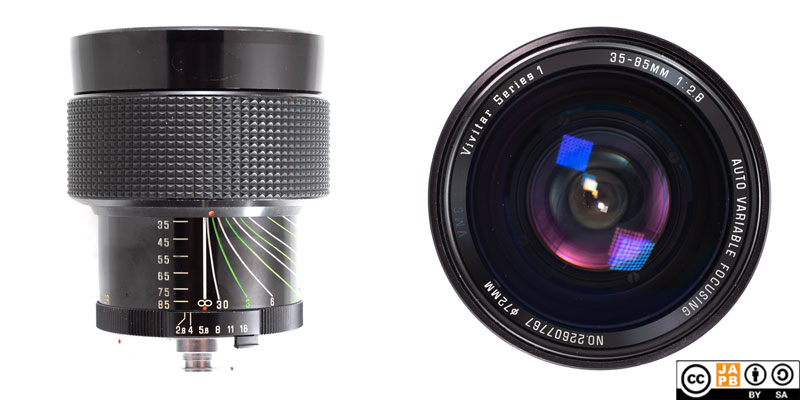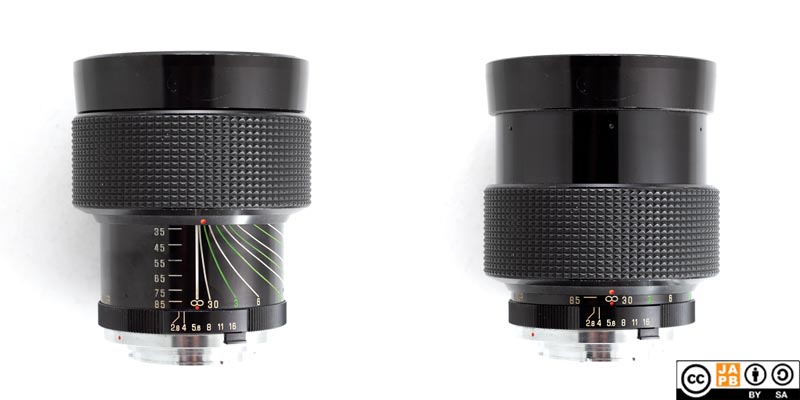Pekka Buttler, 03/2024

Specifications
The table below summarizes the lens’ key specifications (measurements based on pictured, last version of the lens):
| Brand: | Vivitar (Series 1) | Lens name | 35-85MM 1:2.8 auto variable focusing |
| Focal length(s)1 | 35–85 mm | Angle-of-view2 | 63,4°–28,5° |
| Maximum Aperture | f/2.8 | In Production | 1974– |
| Lens mount (this lens) | Minolta SR (MC variant) | Other lens mounts | multiple3 |
| Length4 | 93,8 mm | Diameter54 | 81,2 mm |
| Filter ring diameter | 72 mm | Weight | 745 grams |
| Lens element count | 12 | Lens group count | 9 |
| Aperture blades (S/R/C)6 | 6 S | Focus throw | 90 ° |
| Minimum focusing distance | 26cm @ 35mm 90cm @ 85 mm | Maximum magnification | 1:3 @ 35 mm7 |
| Has manual aperture ring | YES | Has Manual focus ring | YES |
| Aperture mechanism type | Automatic | Aperture click stops 8 | 2.8-4•5.6•8•11•16 |
Further notes:
• This lens is part of Vivitar’s premium ‘Series 1’ lineup. In fact, it is one of the first half dozen lenses that were specifically designed by Vivitar to combine affordability with quality.
• When Vivitar introduced the Series 1 35–85mm f/2.8 in 1974, it was something of a major event. Not only was Vivitar the first off-brand marque to introduce a zoom ranging from moderate wide-angle past standard into the short tele range while keeping a constant f/2.8 aperture, they managed to come in as an overall third after the Konica 35-100/2.8 Varifocal and the Voigtländer 36–82/2.8 zoomar. Moreover, unlike the Konica Varifocal and the Voigtländer Zoomar, the Vivitar was both somewhat affordable and a bit more portable. As another an indicator of how on the leading/bleeding edge this design was: It took until 1987 for Nikon and to 1993 for Canon to introduce a standard zoom with a constant aperture of f/2.8.
• This lens is a ‘variable focusing zoom’ meaning that it does not even try to be parfocal, and readjusting focus after changing focal length is an absolute must.
• The lens is a one-ring, push-pull zoom, where you pull the ring towards the camera to zoom in.
• The overall length of the lens changes both during zooming and focusing, but the changes are relatively modest. While the front filter threads do rotate when zooming, they do not rotate when focusing.

Versions
Only one version of the Vivitar Series 1 35–85/2.8 was ever made, but that version was manufactured for a broad range of lens mounts, which in itself leads to some variation (with the difference in flange focal differences ranging from 40,5 mm to 46,5). Hence the length of the lens will vary significantly based on which lens mount it has. Similarly, some lenses will be all-black, some lenses will have a narrow silver band at the mount-end (such as the pictured lens).
However, there is nothing to indicate that any of these cosmetic variations would correspond to any
History of Vivitar
Vivitar initially was the trade name used by Ponder & Best Inc. until Ponder & Best changed its name to Vivitar Corp. From the 1960s to the early 2000s the company contracted various (mostly Japanese) optical and electronics manufacturers to manufacture photographic gear to be branded as Vivitar.
You can read more details in the Vivitar company profile.
Adapting
n.B! The following applies to all Minolta SR mount lenses.
This lens cannot be used natively on any current SLR or dSLRs. To use it in its native environment, you will need a Minolta SR (SR/MC/MD/X-600) film camera. Luckily these are quite easy to find. To use the lens’ full designed capabilities, a Minolta MC-compatible body (any Minolta SR body launched after 1966) is most recommended..
Thanks to being a fully manual lens (manual aperture, manual focus), the lens can be adapted to all mirrorless cameras using a suitable adapter. Moreover, a simple ‘dumb adapter’ will do the job perfectly. Thanks to the popularity of the Minolta SR mount, the availability of adapters to all mirrorless mounts can be taken for granted, on the other hand, specialist adapters (speed boosters, helicoid adapters, tilt/shift adapters) are not available for all mirrorless mounts, but daisy-chaining adapters (e.g. Minolta SR -> Canon EF; Canon EF –> mirrorless) can offer a work-around.
Using Minolta SR mount lenses on dSLRs is also be an option, but it is not trouble-free due to that the Minolta SR mount’s flange focal distance is shorter than that of any dSLR mount (technically with the exception of Olympus’ four thirds mount). Hence, any attempt at adapting Minolta SR lenses must rely on an adapter that uses corrective optics to allow infinity focus. However, such adapters are readily available.
Footnotes
- Focal length is (unless stated otherwise) given in absolute terms, and not in Full-frame equivalent. For an understanding of whether the lens is wide/tele, see ‘Angle-of-view’. ↩︎
- Picture angle is given in degrees (based on manufacturers’ specs) and concerns the diagonal picture angle. Rule of thumb:
> 90 ° ==> Ultra-wide-angle
70–90 ° ==> Wide-angle
50–70 ° ==> Moderate wide-angle
40–50 ° ==> ‘Standard’ or ‘normal’ lens
20–40 ° ==> Short tele lens
10-20 ° ==> Tele lens
5-10 ° ==> Long tele lens
< 5 ° ==> Ultra-tele lens ↩︎ - Including: Canon FD, Contax/Yashica, Konica AR, M42, Minolta SR, Nikon F, Olympus OM and Pentax K ↩︎
- Length is given from the mount flange to the front of lens at infinity. ↩︎
- Diameter excludes protrusions such as rabbit ears or stop-down levers. ↩︎
- S=straight; R=rounded; C=(almost)circular at all apertures. ↩︎
- The lens ‘suffers’ quite a bit of focus breathing. However, this improves the maximum magnification figures significantly. ↩︎
- Numbers equal aperture values on aperture ring; • intermediate click; – no intermediate click. ↩︎